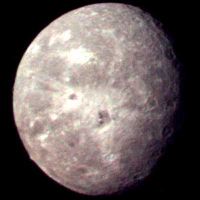Oberon
Oberon is the second largest and second most massive natural satellite of Uranus. It is one of the five satellites discovered prior to the Voyager 2 encounter of January 1986. It is named after a character from William Shakespeare's A Midsummer Night's Dream.
Oberon has a radius of 761.4km. Its surface gravity is 0.349m/s^2, 0.036 that of Earth. A surface orbit has a speed of 515m/s, and the escape velocity is 729m/s. A surface orbit has a period of 9283s (about 2 hours 35 minutes).
Oberon's orbit about Uranus is almost perfectly circular and equatorial, and has a radius of 583400km. Its orbital period is 13.463 days. This is the outermost of the five major satellites.
Like all the satellites of Uranus, Oberon's axis is tilted 98° relative to the ecliptic plane. It is locked in synchronous rotation, like the Earth's moon. When Voyager flew past, Uranus and all its satellites were near their southern summer solstice, and in this case it means that only the southern hemispheres were visible. As a consequence, only the southern hemisphere of Oberon has been mapped in any detail.
Oberon is a satellite included in the Orbiter base installation. It has no bases on its surface.
| Uranus's natural satellites |
|---|
| Named Satellites:
Ariel | Belinda | Bianca | Caliban | Cordelia | Cressida | Cupid | Desdemona | Ferdinand | Francisco | Juliet | Mab | Margaret | Miranda | Oberon | Ophelia | Perdita | Portia | Prospero | Puck | Rosalind | Setebos | Stephano | Sycorax | Titania | Trinculo | Umbriel Numbered Satellites: |
| See also: Pronunciation key | rings of Uranus |
 | This natural satellite related article is a stub. You can help Orbiterwiki by expanding it.
|
